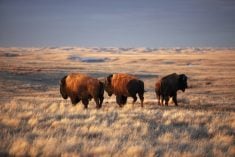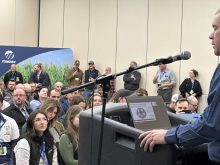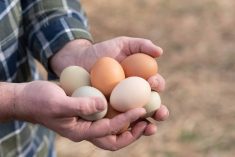We begin with sad news for readers who haven’t already heard: Les Henry, a soil scientist and university professor dedicated to the improvement of Prairie farmland, and a mainstay in these pages for almost 50 years, left us on June 14 at age 83, ending a long fight with congestive heart failure.
We can defer to Les himself on the details of his life and career, as he wrote his own obituary, which you’ll see beside his final Grainews column on pages 20-21, and he even offered up a music suggestion from the Chairman of the Board for the occasion. (We’ll pause here for a second while you call that up.)
If you’d like to hear some of Les’s advice in his own voice, check out his address to University of Saskatchewan ag and veterinary students at their spring convocation two years ago, when the U of S conferred an honorary doctor of laws degree on him. (That’s also up on YouTube. When you get there, scroll ahead to about the 46-minute mark.) I won’t repeat it all here, but he did emphasize lifelong learning as an ongoing objective, not just for the graduates but for all of us. “You don’t need to think that when you step out of here, the learning ends,” he said. “Anytime you think you know it all, it’s time to hang up your soil probe, or your scalpel.”
Read Also

Gentle treatments for pain in the neck
Heading toward year-end, people unknowingly tense up against the cold and busyness, causing neck pain that can often be treated with appropriate support and gentle mobility, athletic therapist Kathlyn Hossack says.
Many thanks to you, Les, for a lifetime seeing to it that we all kept learning.
Soil under study
I’d have been interested to know what Les would have made of the new report from Canada’s standing Senate committee on agriculture and forestry. The Senate gets a bad rap — not all that undeserved, as it often seems the Chamber of Sober Second Thought is more the Chamber of Patronage Appointments or the Chamber of Black-Belt-Level Partisan Bickering — but the upper chamber can and does produce good reading, and “Critical Ground: Why Soil is Essential to Canada’s Economic, Environmental, Human, and Social Health” is no exception.
The title isn’t quite as nuanced as the report itself, which goes a long way to acknowledge improvements in soil management and farming practices since Herb Sparrow’s previous 1984 Senate report, “Soil at Risk: Canada’s Eroding Future.” But it does caution those improvements have “masked the effect of continued soil degradation and loss of agricultural land in every region of Canada” to climate change, ever-more-frequent extreme weather events such as droughts, floods and fires, continued urbanization and “misread outcomes of soil management practices.”
The new report’s often-quoted summary line is “We do not have another 40 years to protect and conserve soil. We must act now.” Being a national-level report, it also offers up a long list of high-altitude recommendations on what sorts of actions the federal government can take. And being an ag committee report, its recommendations also lean heavily on federal agriculture policy and supports for initiatives at the farm level.
But the trick is, as the new report’s authors acknowledge they were repeatedly told, “a ‘one-size-fits-all-approach’ to soil health does not work and that policymakers must consider regional differences.” Even one of the report’s federal-level recommendations — that Ottawa bring back the Prairie Farm Rehabilitation Administration (PFRA), with eyes on sustainable farming, erosion prevention and, of course, shelterbelting — calls for the revival of a regional agency.
As Les’s column on canola yields shows us, soils differ wildly even within the confines of agricultural Saskatchewan — and even more so across Canada. To its immense credit, the report breaks down the strengths, weaknesses and challenges facing Canadian soils on a region-by-region basis, looking not just at the Prairies but at B.C., central Canada, the Maritimes, Indigenous lands, forested regions, the territories — and, under unique threat from climate change, our country’s potentially impermanent permafrost and the carbon lurking therein.
As disparate as Canada’s soils are, though, we can’t afford not to consider them at the national level. Naming a national soils advocate, as the report recommends, would help, as would the “development of a consensus on how to measure, report and verify soil health” and the creation of a national soils database, with data to be collected “at different points in time to adequately measure change over time” and, ultimately, “an annual report on soil health for the country.”
In other words, while specific problems call for us all to act regionally, it’s also time to start gathering and sharing the data we need to think nationally.
Meanwhile, we’re always interested in your thoughts on the matter(s). Assuming this report doesn’t just go to gather fine particulate soils on the shelf, what sorts of help do you need for your land? What would you like to see from a PFRA 2.0, if that were ever to happen? Drop us a line.
















